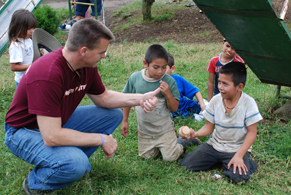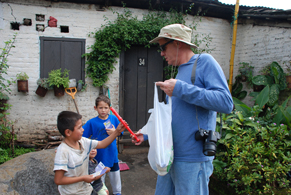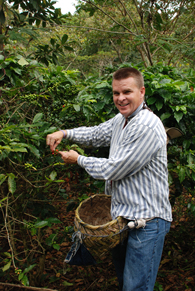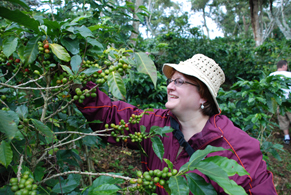November 8, 2008
This morning we visited the worker’s housing on Selva Negra. Coffee harvest starts in November and continues through February. During the harvest the farm employees from 600-1,000 pickers but there are about 300 year round staff that remain working on the farm doing maintenance to equipment and the fields as well as working at the hotel and restaurant. Of the 300 permanent staff 50 families (some have two or more employees) live in concrete family with an outside private bath facility. In addition, there is a school for children through sixth grade for all farm staff as well as classes at night for adults. Every person on staff is encouraged to learn to read and write. Children that successfully complete sixth grade may attend high school in Matagalpa and if they want Selva Negra (sometimes with the help of some of their bigger buyers) will pay for them to attend university or trade school.
There is a health care clinic in the family housing area. A resident nurse provides standard care and education in hygiene as well as healthy living and physical education. Family planning is an important topic. The average family size has decreased from 12+ children to and average of 4 per family since these services have been provided. Some families chose to have just one child.
Every worker is provided with three meals a day served in the worker’s kitchen. A typical meal includes vegetables from the farm, tortillas, and protein. Corn for the tortillas is not grown on the farm but the tortillas are made fresh each day for the meals. During peak picking season an automated tortilla maker is used.
The standard of living is much lower than in the United States. Homes are about 600 square feet with a kitchen and one large room divided into sleeping and family areas. Tiled bathrooms with underground sewer are located outside and laundry is washed in a community area at washboard sinks. Families have very few possessions but as we walked through the housing area we could quickly tell the pride the families had in their simple homes. There were beautiful flower gardens and other landscaping, murals, and many doors were decorated. The children loved seeing the visitors and we came prepared with small gifts of toys and candy. Travelers also provided Mausi with clothing and school supplies.


From the worker’s housing we moved on to the stables to see the animal farm part of the business. The beef cattle are grazed off the main farm while, 500 laying hens, broilers, quail, a milk heard of 200, and pigs are raised on the main property. Mausi wants the farm operation to be as self sufficient as possible. Most of the food they grow is used to feed the workers and the hotel guests. Nothing goes to waste. In the event they cannot use a food item they produce it is sold in the local area. Future operations will include a free-range pig lot, a larger cheese making facility, gourmet chocolate, and goats.
Selva Negra also runs a hotel and restaurant. This part of the business helps keep the staff busy during non-harvest time and also provides a non-coffee related income. The hotel cabins were planned to fit into the landscape with a careful watch not to remove trees and plants. The resulting resort is a bit rustic but is also quite comfortable. The menu at the restaurant has some German items as well as local recipes. The restaurant features items grown on the farm and of course also sells coffee.
 In the afternoon we went to try coffee picking. There were 15 untrained pickers plus our host Steve, the foreman, and Mausi. We strapped on our coffee baskets and headed into the coffee field. The goal was to pick as many ripe cherries as possible (no stems) and to leave the trees in good shape with the green (unripe cherries) in place. Oh, and we had to be careful not to step on the smaller coffee trees planted between the rows. (They replant about 250,000 trees a year and rotate out fields to new coffee trees as the older trees yield less coffee. A coffee tree takes about three years to yield a harvest.)
In the afternoon we went to try coffee picking. There were 15 untrained pickers plus our host Steve, the foreman, and Mausi. We strapped on our coffee baskets and headed into the coffee field. The goal was to pick as many ripe cherries as possible (no stems) and to leave the trees in good shape with the green (unripe cherries) in place. Oh, and we had to be careful not to step on the smaller coffee trees planted between the rows. (They replant about 250,000 trees a year and rotate out fields to new coffee trees as the older trees yield less coffee. A coffee tree takes about three years to yield a harvest.)
We quickly learned that picking coffee was no easy task. After about an hour and a half of work all of us together only had one basket of coffee cherries or about $1.00 in wages. When processed the coffee we picked would yield about one pounds of beans or about 36 cups of coffee.
 Life on a coffee farm is not easy. There is a lot of hard work but the lives of the employees of the Selva Negra farm are much better than most. Generations of families have lived on the farm due to the benefits provided.
Life on a coffee farm is not easy. There is a lot of hard work but the lives of the employees of the Selva Negra farm are much better than most. Generations of families have lived on the farm due to the benefits provided.
Tomorrow we are going to explore the protected rainforest on Selva Negra and we’ll be visiting a neighboring farm.



